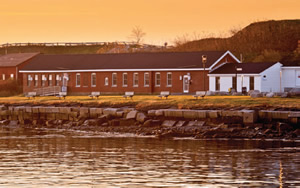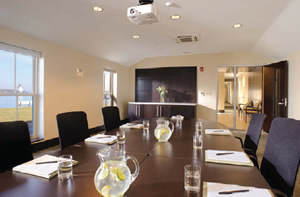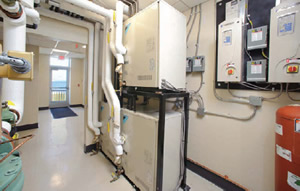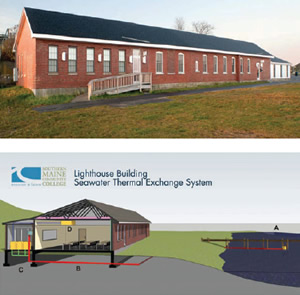By the Sea
A seawater HVAC system is the latest in a Maine college’s green efforts.
- By Rob Klinedinst
- 10/01/13

IMAGES COURTESY OF HARRIMAN ARCHITECTS & ENGINEERS
In its latest effort in an ongoing program to green its campus in South Portland, Southern Maine Community College (SMCC) turned to an innovative way to heat and cool one campus building — with seawater!
Tapping into nearby Casco Bay, the seawater-based system uses a variable refrigerant volume (VRV) configuration with geothermal heat pumps to heat and cool the 3,250-squarefoot Lighthouse Building, which houses the school’s arts program and offices for The Foundation for Maine’s Community Colleges.
Initial roadblocks to using seawater were finding equipment that could efficiently handle the wide temperature ranges in Casco Bay — from 33°F in winter to 60°F in summer — and the corrosiveness of salt water. Only one heat pump unit was found with a heating water temperature range of 14°F to 113°F, and this was coupled with a system used in the maritime industry — a cupronickel underwater “ship-keel cooler” heat exchanger — that is highly resistant to saltwater corrosion. On ships the heat exchanger is used to reject heat; here it is used to both extract and reject heat from and to the sea.

Why It Works
Essentially, the system either absorbs or rejects heat from seawater.
While it is difficult to image how heat can be extracted from nearly freezing water, a household refrigerator basically does the same thing. It mechanically moves heat from one location to another. A refrigerator uses a small electric compressor to compress a gas (refrigerant) to a liquid state. This process requires electric energy and imparts energy to the refrigerant, changing its state and raising its temperature. The liquid refrigerant is first cooled and then allowed to expand back to a gas within the area that is to be cooled (the refrigerator freezer coil section). This process requires heat and so “extracts” that heat from inside the household refrigerator and can lower the temperature within the freezer to 0°F. The simple household refrigerator has the capability to remove heat (cool) from a freezer compartment when it is at or near 0°F. It keeps food cool inside while rejecting that heat outside of the unit via the coils in the back/bottom of the unit.

SMCC’s Design
In the SMCC system the same basic process occurs. The “refrigeration” equipment extracts the heat from the seawater via the heat exchanger at varying temperatures and rejects it to the occupied spaces of the building. How much easier this must be with seawater that is much warmer than the inside of a refrigerator freezer. So too, when we wish to cool the building we can move heat from the building to the seawater heat exchanger by reversing the path of the refrigerant in the compressors.
The concept is similar to geothermal systems but with a much colder resource and without the drilling expense. The cupronickel heat exchangers are located under a nearby dock and positioned three feet below low tide. An uninsulated pipe loops between the heat exchanger and the building. Running the pipes under the ground — an added geothermal source — eliminated the cost of insulated piping. The pipe is filled with 50 percent food-grade propylene/glycol, with inline pumps moving the liquid at 75 gallons per minute.
One eight-ton and two six-ton VRV compressors — essentially, geothermal heat pumps — serve the building using 16 evaporators. The ventilation air is ducted directly to the evaporators for conditioning prior to introduction into the spaces, allowing each space to be heated or cooled independently. Each of the VRV compressors covers one-third of the building. The VRVs with their variable-frequency drives can operate their compressors to exactly match the instantaneous loads in cooling, heating or just energy-movement functions.
Branch-selector boxes make this a heat recovery VRV as opposed to a heat-pump VRV. With heat-pump systems the entire building is either in a heating or cooling mode. With heat recovery, each individual evaporator can either cool or heat totally independent of one another. Spaces are either heated or cooled by the evaporation units, or energy can be moved from one space to another, hence the term “heat recovery.”
The Benefits
Environmental hurdles were overcome to permit this adaptive and extremely energy-efficient technology to be used at SMCC. It is environmentally friendly, uses no fossil fuels, and releases no byproducts. The Lighthouse Building uses only electricity to move energy via the geothermal heat pumps.
Before the system was installed the building consumed 2,000 gallons annually of oil for heating, and there was no installed air conditioning. Compared to a conventional oil-fired heating/direct expansion cooling system, the new set-up reduces heating costs by 33 percent and cooling costs by 27 percent. Ocean water has proven to be an amazing source of potential heat even during winter months. In the 24 months since the system has been operating, the college has seen a $10,600 savings in energy costs annually.

HOLDING THE FORT. An innovative geothermal system that couples nearby ocean water with a variable refrigerant volume (VRV) HVAC system converted a series of structures once belonging to an historic fort in South Portland, ME, for Southern Maine Community College.
While the system cost $84,000 more than a conventional HVAC configuration, its reduced operating costs and no fuel cost produce a payback period of less than eight years.
Other Sustainable Measures
The envelope of the building was brought up to modern standards with walls insulated with sprayed foam with an R-value of 16.2 and highly efficient windows, and six inches of sprayed foam insulation was added to the roof for an R-value of 32.4. All these measures helped reduce system costs.
SMCC, located in South Portland, established the Sustainability and Energy Alternatives Center (SEA), the centerpiece of initiatives to drive sustainability. The seawater HVAC system is just one example that has emerged along with this initiative and has made SMCC a leader of first-use sustainable technology in the college world.
This article originally appeared in the College Planning & Management October 2013 issue of Spaces4Learning.